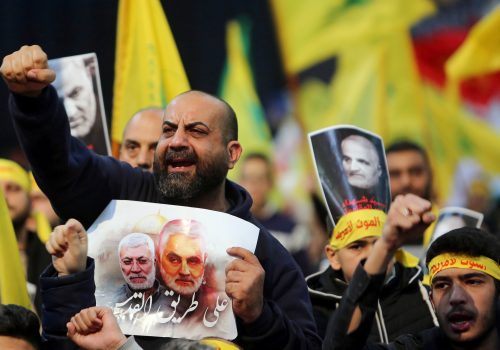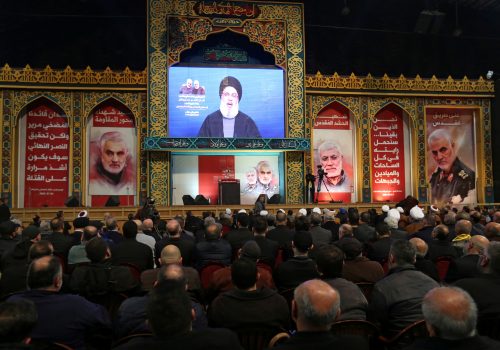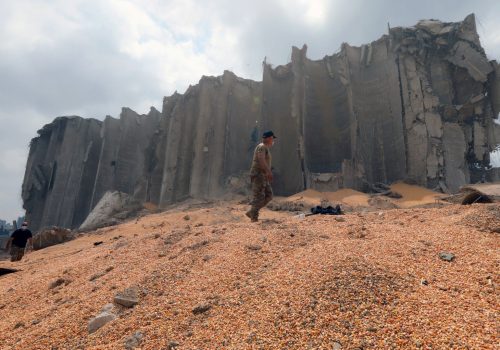Hezbollah is using propaganda to cover its deterrence deficit with Israel
Tensions between Lebanese militant group Hezbollah and Israel have elevated since the July 20, 2020 Israeli airstrike on Damascus that killed the group’s fighter Ali Kamel Mohsen. Hezbollah should have avenged Mohsen by now and its continued failure to do so is creating a growing “deterrence deficit” vis-à-vis Israel. Hezbollah will likely use armed force to bridge this gap when more opportune conditions arise in Lebanon. Until then, the group is using propaganda to maintain the impression that its balance of terror with Israel has not lapsed.
Hezbollah’s perceived ability to resist Israel is a cornerstone of the group’s popularity among its Lebanese Shia supporters. Compared to other Lebanese, the sect has suffered disproportionately from Israel’s often brutal military adventures in Lebanon and, as a result, accept Hezbollah’s propagandistic portrayals of the Jewish state as a diabolical entity set on occupying and destroying Lebanon.
Per its narrative of “Resistance” against Israel, Hezbollah must always be victorious, continually growing stronger, and imposing its will on Israel. The Jewish state, in turn, must gradually weaken until its ultimate demise at the hands of the Resistance’s mujahideen—sometimes portrayed as Hezbollah’s fighters alone or, in Secretary-General Hassan Nasrallah’s more sober moments, the combined forces of the “Resistance Axis.” Hezbollah’s media often buttresses this claim of a declining Israel by carrying decontextualized or exaggerated translations of articles from the Hebrew press reflecting Israeli vulnerability.
However, by inserting Divine Providence into this mundane clash, Hezbollah’s narrative negates the admissibility of the inevitable strategic setbacks in such protracted struggles. Certain losses, like the death of a storied commander, are considered acceptable. However, general Israeli ascendancy—or general Hezbollah weakness—risk undermining the foundations of “Resistance.” Therefore, the group must always project strength against Israel—formulated as constant readiness to confront and repel “Israeli aggression,” even if it is currently unable to “liberate all of Palestine.” This strength-projection, in turn, is premised upon Hezbollah successfully establishing and maintaining “equations of deterrence” and a “balance of terror” with the Israelis. Or, at least, pretending to do so. Israel unilaterally setting new “rules of the game” risks making Hezbollah appear helpless, potentially undermining its utility to many of its supporters.
On August 25, 2019, Hezbollah established such an equation. Israel had just killed two junior Hezbollah operatives in Syria and allegedly sent kamikaze drones into Beirut. Nasrallah vowed henceforth that his group would “retaliate [from with]in Lebanon” “if Israel kills any of our brethren in Syria.” He also promised Hezbollah would target some of the drones that Israel regularly deployed inside Lebanon. The group followed up a week later with an anti-tank-guided missile attack on an Israel Defense Forces (IDF) patrol. The strike was largely theatrical and failed to cause IDF casualties. But it was sufficiently violent for Hezbollah to put Israel on notice and assure its supporters that the Resistance was powerful via its media’s exaggerations.
When Israel killed Mohsen last summer, it effectively—albeit unintentionally—annulled the August 2019 “Equation.” Hezbollah couldn’t respond as forcefully as it had before. According to the group, every retaliation against Israel carries a minimal risk of unintended escalation that could lead to an undesired war. Hezbollah’s current constraints made the risk too high. The intervening year’s events in Lebanon—social upheavals, an unprecedented and ongoing economic and social collapse, and the outbreak of COVID-19—have forced Hezbollah to operate more responsibly lest it compounds Lebanese miseries with security conflagrations or war.
Hezbollah attempted to project battle-readiness by targeting Israeli drones operating in Lebanese airspace and deploying its own reconnaissance drones into Israeli territory, acting on the bloodless component of its 2019 Equation, which carried virtually no risk of escalation. Hezbollah’s attempts to avenge Mohsen—on July 27, 2020 and August 26, 2020—were muted affairs and ended in failure. This led the group to unusually deny responsibility for the first attack and, in contrast to previous reprisals against Israel, claim it was indefinitely delaying retaliation. Meanwhile, its propaganda organs spun a new narrative, claiming fear of the “Resistance” had so unnerved Israeli troops that they had fired at mirages.
Absent a successful retaliation, the claim that the IDF was crippled by fear of the Resistance became Hezbollah’s new propaganda mainstay. In fact, while Deputy Secretary-General Naim Qassem stressed that the group’s August 2019 Equation remained unmodified, he and Hezbollah’s leadership subtly rewrote it to center on the alleged terror gripping Israel’s forces. Now, delaying retaliation wasn’t a sign of the group’s weakness. Instead, because it was allegedly keeping the Israelis waiting in fear of reprisal, the delay was itself “part of the punishment” and proved the equation’s endurance.
Nasrallah claimed this terror was forcing “this powerful regional army” to suspend “their training exercises, maneuvers, and movements” along the border and “stand on a foot-and-a-half.” Executive Council Chairman Hashem Saffiedine also alleged that fear of the Resistance was preventing Israel from “engaging in much direct action.” Hezbollah’s media outlets and leaders maintained this claim even after the Israelis had resumed “operating openly and massively on the border for weeks,” as Yedioth Ahronoth reported in early January.
In addition to operating normally along the Lebanon-Israel border, the IDF had resumed massive exercises simulating fighting Hezbollah—of the same type Nasrallah said Israel was too fearful to undertake—as early as October. The Israeli Air Force (IAF) also continued daily aerial incursions into Lebanon and increased its airstrikes in Syria, presumably targeting the group’s weapons shipments, with each strike carrying a risk of killing another Hezbollah fighter. The IAF even carried out at least one of these airstrikes from Lebanese airspace.
Nasrallah was ready with a response that fit these Israeli activities into Hezbollah’s narrative that Israel was living in fear of the Resistance. He mischaracterized October’s offense-focused “lethal arrow” exercise as preparation against an invasion of the Galilee by Hezbollah. He applied the same logic to the IAF’s aerial incursions, insisting that, since the rise of Hezbollah, the Israelis had shifted the weight of their operations in Lebanon to their air force because IDF ground forces feared confronting the Resistance.
However, Hezbollah’s ongoing dilemma was highlighted again by Israel’s Military Intelligence Directorate’s (Aman) annual intelligence estimate, which was released in early February. The report stated that COVID-19 hadn’t weakened the group and noted its readiness to engage Israel in “battle days” for the first time since the 2006 Lebanon War. Nevertheless, Aman stressed that this was not borne out of the strength Hezbollah had been trying to project, but its sense of weakness for failing to avenge Mohsen—a “deterrence deficit” growing in Israel’s favor. The assessment stressed that Hezbollah wouldn’t strike Israeli civilian population centers or deep into Israeli territory for fear of igniting a war. It also undercut the current threat posed by the group’s precision-guided missiles, saying Hezbollah only possessed “a few dozen” PGMs—the same number as in late 2018.
Pro-Hezbollah mouthpiece Al-Akhbar attempted to spin the assessment in the group’s favor. It claimed Aman had revealed to Israeli media only “a small portion…of the threats” posed by Hezbollah, including underestimating the group’s “hundreds” of PGMs, and claimed that the organization had “imposed battlefield and strategic realities” on Israel. Meanwhile, the IDF was engaged in a massive training exercise dubbed “Lightning Storm” to prepare for the aforementioned “battle days,” followed by “Galilee Rose,” which simulated aerial superiority over Lebanon and Syria.
Hezbollah took note. The group’s Al-Ahed claimed “fear of Hezbollah” had prompted the exercises. In his February 16 speech, Nasrallah tried to project strength where Aman’s assessment had suggested weakness. He threatened that Hezbollah would target Israeli civilians and cities housing security installations. To subtly counter Aman’s claim of a deterrence deficit, he also stressed that Israel could no longer freely threaten Lebanon because “we are living in the age of Resistance.”
Nasrallah’s speech formed the centerpiece of Hezbollah’s subsequent propaganda blitz. Its media echo chamber now claimed that Nasrallah’s latest threats expanded the existing deterrence equation. The group’s Central Military Media also released one of their typical videos meant to magnify the group’s alleged military sophistication, showcasing the security targets in Israeli cities that Nasrallah had threatened to strike in a future clash. Some Hezbollah allies hailed the video, whose content was culled from open-source platforms, due to an “intelligence coup” in Israeli territory.
Lebanon’s ongoing collapse will continue to constrain Hezbollah’s actions against Israel for the foreseeable future. Its leaders have repeatedly expressed their disinterest in initiating war, “seeking a confrontation,” or existing in the “battle days” predicted by Aman. However, the group buries these de-escalatory messages in threats to maintain its followers’ belief in its ascendancy vis-à-vis Israel. Hezbollah won’t necessarily suspend all operations against its archenemy, but it will have to deftly navigate both Lebanon’s predicaments and its support base’s expectations. In the meantime, its propaganda will cover its lack of armed action.
David Daoud is a nonresident fellow at the Atlantic Council and a research analyst on Lebanon and Hezbollah at United Against Nuclear Iran (UANI). Follow him on Twitter: @DavidADaoud.
Image: A banner depicting Hezbollah leader Sayyed Hassan Nasrallah and an United Nation's post are seen in Lebanon from the Israeli side of the border, near Zar'it in northern Israel August 28, 2019. REUTERS/Ammar Awad


